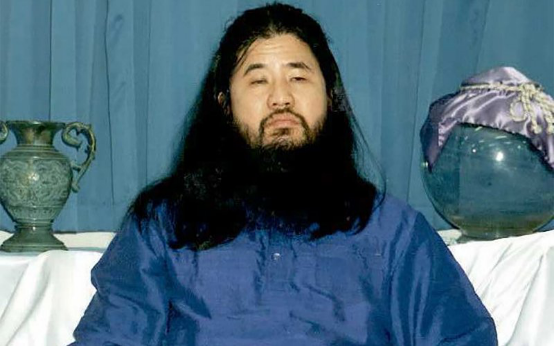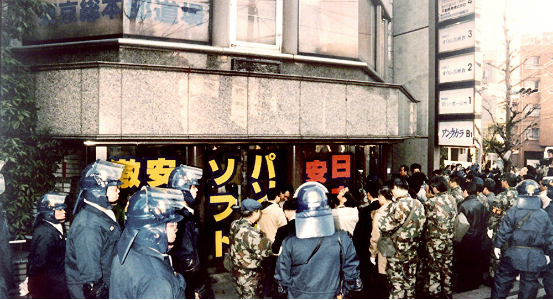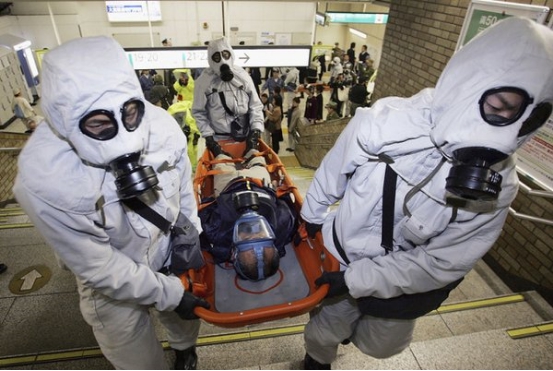
ROME — The Japanese Doomsday cult Aum Shinrikyo (Supreme Truth) has been pretty quiet since its members, following the orders of its founder, Shoko Asahara, killed 13 people and sent more than 5,000 to the hospital in a gruesome sarin gas attack on the Tokyo subway in March 1995. But apparently that relative silence doesn’t mean they’ve stopped their madness.
Last week, 58 people believed to be affiliated with the creepy cult were caught at a seedy hotel in Danilovgrad, Montenegro, where they were holding a conference, according to Montenegro press reports. Some were watching motivational videos of cult leader Asahara on a laptop, and others were practicing yoga in linen pajamas. According to Montenegro press reports, the group had rented the entire hotel from March 16 so they could “hold their conference without being bothered by outsiders.”

What were they up to, really? It appears only a few were Japanese; most were from nations that once formed part of the Soviet Union, where a weird spin-off of the already very weird cult has taken shape over the years. But even if they had no direct contact with the Tokyo subway killers, local authorities had no reason to assume that admirers of the cult founder are benign.

Aum Shinrikyo was the first—and to date the only—terrorist group to launch a sophisticated chemical warfare attack. It had invested a fortune developing the technology to manufacture a weapon first produced by the Nazis in the 1930s that, even now, al Qaeda and the so-called Islamic State can only dream about: a colorless, odorless nerve agent that causes victims to suffocate within ten minutes and may do permanent neurological damage to those who survive. It is classified as a weapon of mass destruction, along with atomic bombs and biological agents. But a more suitable description would be weapon for mass murder. In 2013, the world got a glimpse of sarin in action when the Syrian regime used some of its stockpile on civilians.
On March 20, 1995, Asahara’s followers dropped five plastic bags filled with sarin in liquid form on Tokyo subway trains at the height of rush hour, simultaneously puncturing them with sharpened metal-tipped umbrellas. Although the death toll was lower than expected, hundreds of people still suffer from the effects of the poison and the trauma of that day.
Many more people likely would have been killed had the agent been dispersed in aerosol form. The cult had plans to disperse the gas over Tokyo with a helicopter purchased from Russia, but it was stopped before it could put the larger plan into effect, according to police officers who worked the case.
Followers of the cult, then and now, worship Shoko Asahara, whose real name is Chizuo Matsumoto. He is currently on death row awaiting the outcome of appeals on multiple convictions related to the 1995 attacks, but the faithful see him as a Christ-like figure. The fact that those in Montenegro were worshiping a man who orchestrated what he hoped would be an apocalyptic incident might indicate that they agree with his philosophy—the fact that they were holding their meeting on the anniversary of the Tokyo attack would appear even more incriminating.
Montenegro, a tiny Balkan country that was once part of Yugoslavia and is now poised to enter the European Union, has a long history as a haven for smugglers—and for tourists—who are attracted to its dramatic Adriatic coastline where mountains rise straight out of the sea. But Danilovgrad, where the cult members were meeting, is deep in the interior.
Of the 58 people expelled by the Montenegran authorities, 43 were Russian, seven were from Belarus, three from the Ukraine, one from Uzbekistan, and only four were from Japan, Montenegro’s interior minister said in a statement. The hotel staff grew suspicious when some of the Russian guests showed what they described as “signs of ritualistic injury” and malnourishment, according to the Montenegro newspaper Vijesti.
After the 1995 Tokyo gas attacks, nearly 200 people were charged with various offenses related to the atrocity. Some members of the cult are still on trial for various felony charges including attempted murder and sending mail bombs. It is not clear if any of those who were found in Montenegro were also involved in any way in those attacks.
At the height of its popularity Aum Shinrikyo had around 40,000 active followers who took part in bizarre rituals orchestrated by cult leader Asahara, who is partially blind. Their rites mixed elements of Christianity, Buddhism and Hinduism with brainwashing to convince followers Asahara had supernatural powers.
According to an article marking the anniversary of the attacks in Tokyo Weekender last year, the group’s initiation ceremonies consisted of hallucinogenic binges on LSD during which Asahara made members reject materialism by handing over their wealth to him. Whether the videos those in the Montenegro hotel were watching amounted to a similar initiation ceremony is unclear, but authorities did find more than €55,000 ($62,660) in cash in one of the rooms.
Asahara supposedly gave followers “superhuman powers” in exchange for their material wealth. Asahara also saw himself as something of a prophet, famously predicting a third world war instigated by the United States.
As details emerged of Aum Shinrikyo’s operation in the 1990s, it came to appear less a religion than a criminal enterprise, manufacturing its own line of computers and making meth-amphetamines that was sold wholesale to the Yamaguchi-gumi Goto-Gumi, a faction of Japan’s largest yakuza, or organized crime, group.
Japanese media outlets Jiji and Kyodo News reported that the Japanese Aum Shinrikyo members in Montenegro were middle-aged men, but there is little information on the others involved.
“We’re not sure of the activities of Aum Shinrikyo overseas,” one Japanese official told The Daily Beast. He said the Russian followers are a runaway sect that spun off from the original cult. “The Russian sect became semi-independent years ago and their links to Japan are tenuous,” said this Japanese source. “The group in Montenegro seems to be an offshoot of the Russian group. They do believe that Matsumoto [Asahara] is a messiah, but are they terrorists? Difficult to say.”
Montenegro clearly didn’t want to take a chance.